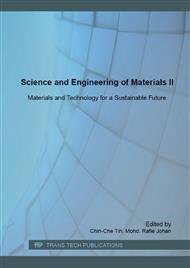p.260
p.265
p.270
p.275
p.281
p.286
p.291
p.295
p.300
The Synergistic Effect of Flame Retardants on Flammability, Thermal and Mechanical Properties of Natural Fiber Reinforced Epoxy Composite
Abstract:
Epoxy was effectively resin infused with 15 %wt intumescing Alumina Trihydrate (ATH) flame retardant (FR) formulations into a 10 %wt palm EFB natural fiber (NF) mat. The effects of ATH and its intumescing blend with Zinc Borate (ZB) and Ammonium Polyphosphate (APP) on flammability, thermal and mechanical properties of the composites were investigated. Compared to neat NF filled epoxy composites, specimens loaded with intumescing blend of FR formulations demonstrated an improved thermal properties, showing greater mass residual which can be attributed to the formation of cross-linked network amongst the NF, FRs and epoxy matrix upon combustion at elevated temperature tested within a TGA instrument. Incorporation of fibers drastically enhanced the mass residue and lowered the heat release compare to the pure epoxy. Addition of the intumescing blend of FR formulations also drastically reduces the combustion heat release, total mass loss and zero drip flame in the NF composites. The optimum FRs formulation with 5 %wt ATH and 10 %wt APP exhibited self-extinguishing property, achieved lowest mass loss and no drip flame under Bunsen burner tests, signifying the synergistic effects between ATH and APP within the NF epoxy composites. APP reacts with the carbonaceous network of NF throughout the ignition period, such interaction formed a thick char layer acting as gas and thermal barrier against the fire mechanism. This reaction does not take place in NF composite specimens without APP. In terms of mechanical properties, NF composites loaded with FRs broadly showed poorer tensile strength, mainly due to the existence of FRs, which acted as a nucleating agent affected the physico-mechanical characteristics of the composites. Amongst the FR rich formulations, specimens with APP or ZB blends seem to possess a more superior tensile strength compared with the neat ATH filled formulation. In addition, composites loaded with FRs showed enhanced Young’s modulus relative to those without addition of FRs.
Info:
Periodical:
Pages:
281-285
Citation:
Online since:
July 2016
Authors:
Keywords:
Price:
Сopyright:
© 2016 Trans Tech Publications Ltd. All Rights Reserved
Share:
Citation:


